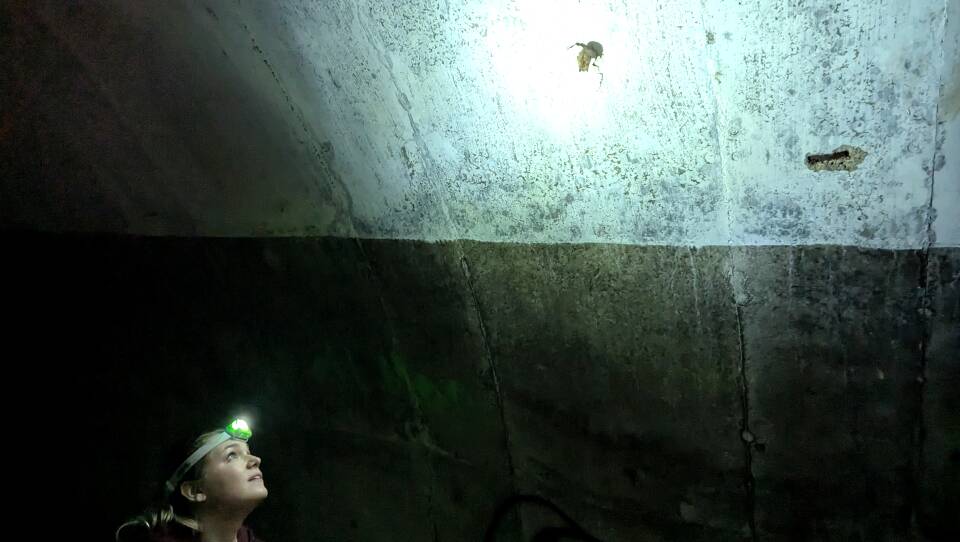This is a web edition of GBH Daily, a weekday newsletter bringing you local stories you can trust so you can stay informed without feeling overwhelmed.
🌧️ Showers likely with a high of 59. Sunset is at 5:40 p.m. It’s day 30 of the federal government shutdown.
“Massachusetts biologist Elise Stanmyer scrambled into the dark of an abandoned World War II military building. She whispered so she wouldn’t wake its winged residents.” Sounds like the start of a spooky Halloween tale, right?
In fact, it’s GBH’s Hannah Loss describing her recent visit to an undisclosed location where scientists are trying to protect the nine species of bat found in the Bay State.
You’ll learn more about these misunderstood mammals — and the people working to save them — below. But first, the news.
Four Things to Know
1. The Trump administration is ending a policy that gave immigrants extra time to renew their work permits. The abrupt change takes effect Thursday.
Immigration attorneys worry that eliminating this grace period could force people out of their jobs this winter, as renewal applications get delayed in growing administrative backlogs. Without a valid work permit, immigrants cannot legally work — and employers often verify those documents.
2. The deputy director of Gov. Maura Healey’s western Massachusetts office was arrested Tuesday evening and charged with cocaine trafficking after police seized eight kilograms of the drug delivered to the Springfield state office building where he worked.
“The conduct that occurred here is unacceptable and represents a major breach of the public trust,” Karissa Hand, spokesperson for the governor, said. She noted that the administration “will work with law enforcement to assist them in their work” as the criminal investigation continues.
3. Boston’s Museum of Fine Arts has returned ownership of two pottery pieces to the descendants of the artist who created them. The stoneware vessels were made by David Drake, a well-known potter who was enslaved in South Carolina in the 1800s.
The museum says Drake was denied ownership and compensation for his creations. Curator Victoria Reed called the decision part of the MFA’s broader effort to return art that was looted or stolen, including during the Holocaust. “To me, it really is about consistency and to make sure that we’re upholding the same ethical standards in all areas of the museum collection,” Reed said.
4. The contours of Massachusetts’ electoral districts are back in the spotlight amid unusual mid-decade redistricting efforts — first in Texas, then in California. National GOP figures, including former California Gov. Arnold Schwarzenegger and Vice President JD Vance, have pointed to Massachusetts’ maps, claiming gerrymandering is the reason the Bay State hasn’t sent a Republican to Congress in decades.
“I kind of laugh when I hear that claim, because first of all, no Republican ever gave us any input into the redistricting process in Massachusetts, because they knew full well that it’s impossible to draw a Republican district in Massachusetts,” said state Senate President Pro Tempore Will Brownsberger, one of the main architects behind the current maps. “This was just never a thing. It was never discussed. Nobody pushed it. We didn’t deny it.”
A Closer Look
Biologists identify these bats by their toe hairs. They’re key to Massachusetts’ ecology.
By Hannah Loss
Massachusetts biologist Elise Stanmyer scrambled into the dark of an abandoned World War II military building. She whispered so she wouldn’t wake its winged residents.
Her headlamp illuminated a lone bat clinging to the wall. It could be thetricolored bat, or perhaps a species known as thelittle brown — both endangered in Massachusetts.
“It’s hard to tell,” she admitted. “One thing we look at to determine little brown bats is how long their toe hairs are.”
Stanmyer works for the Massachusetts Department of Conservation and Recreation. Part of her job involves monitoring thenine bat species found in the Bay State.
On this October day, she’s setting up a bat detector — an acoustic device used to record bat calls at sunrise and sunset. Later, she’ll run those vocalizations through software to identify which bat species are using this human-made cave, now adorned with graffiti and littered with rubber tires and empty cans.
Explore the bat lair with Stanmyer here.
Dig Deeper
After last year’s fire, volunteers track new life at Blue Hills
Massachusetts ecologists build a winter ‘hotel’ for snakes
For blind and low-vision nature lovers, birding is 'by ear’





